 Ottoman Navy: Ironclads Asar-i Şevket, Necm-i Şevket (1867-1870)
Ottoman Navy: Ironclads Asar-i Şevket, Necm-i Şevket (1867-1870)
After Asar-ı Tevfik only member of her class and built in France at FMG Bordeaux at first for the Khedivate of Egypt the new Ottoman Naval expansion program after the Crimean War planned to order to smaller, cheaper ironclads to the same yard. This was the Asar-i Şevket class, built about the same time as Asar-ı Tevfik, close in design but smaller and with a revised armament. They had a long career. They took part in the Russo-Turkish War of 1877–1878 in the Black Sea and Caucasus campaign, and in reserve until 1897, taking part in the Greco-Turkish War, but in such poor condition they did little. Asar-i Şevket was decommissioned in the 1900s but Necm-i Şevket still provided fire support against the Bulgarians in the First Balkan War in 1913 and was used as barracks ship until decommissioned on 1929.
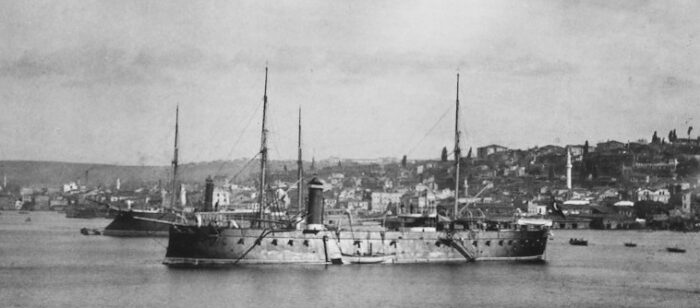
Design of the class
Development
In the early 1860s, the Eyalet* of Egypt (still an autonomous province of the Ottoman Empire) ordered several ironclads to bolster its fleet, as part of a massive rearmament program to try to challenge the central government in Istambul. Memories of the Second Egyptian–Ottoman War twenty years earlier were stilll vivid. The plan included the large Asar-i Tewfik two smaller Asar-i Şevket-class, all ordered in 1866 to France’s Forges et Chantier de la Gironde shipyards (FCG). This was a real threat for the Ottoman navy, which, albeit dwarving the Egyptian’s in size, was only made of traditional wooden corvettes, frigates and ships of the line at the time. A special Ottoman emissary arrived with a delegation from Istanbul and started long negotiations with Cairo, managing to reach a compromise and concessions. The crisis was eventually averted, and against proper funding, the three Egyptian ironclads were transferred to the central government on 29 August 1868.
*An Elayet is local Ottoman governor, in a Khedivate (autonomous vassal state) in 1867 with Isma’il Pasha being Khedive until 1879.
The trio of ironclads ordered to France proceeded on a common design, with the same basic battery of Armstrong guns, but the massive Assar-I Tewfik was beyond Isma’il Pasha’s finances at the time, and the yard proposed a smaller variant, which was accepted and became the Asar-i Şevket class. A reduced version sharing a central battery arrangement with superimposed barbette for a unique 229 mm or 9-in heavy gun. It was completed by four 178 mm (7 in) Armstrong guns whereas the previous Ironclad had eight 229 mm (9 in) guns. A significant downgrade. Asar-i Tevfik was closer in design to ships such as the Colbert class in France. In general context, the rule of Isma’il was very much under French influence. The suez canal started in 1859 was inaugurated in 1869 with a grand ceremony. However his grand reforms were out of reach from the country’s resources and his personal extravagance led eventually to bankruptcy, leading to European intervention and deposition in 1879.
Hull and general design
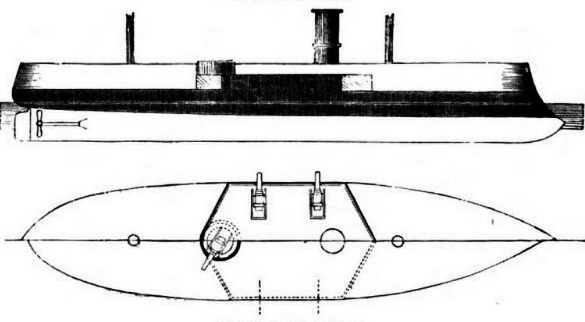
The Asar-i Şevket class ironclads were 66.4 m (217 ft 10 in) long overall, 62 m (203 ft) long between perpendiculars. They were twenty meters shorter than the Assi-i Tewfik at 83.01 x 16 x 6.5 meters (272 ft 4 in x 52 ft 6 in x 21 ft 4 in). Smaller beam of 12.9 m (42 ft 4 in) and lighter draft at 5 meters (16 ft 5 in). The hull was constructed with iron, not wood, and incorporated a ram bow and double bottom for a displacement of 2,047 metric tons (2,015 long tons; 2,256 short tons) at normal load. By comparison Asar-i Tewfik displaced twice as much, at 4,687 t (4,613 long tons; 5,167 short tons).
Both ironclads also had a crew of 170 officers and enlisted men.
Powerplant
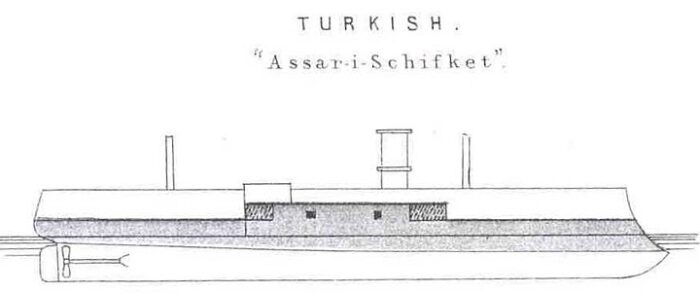
The Assar-i Tewfik had a shaft compound steam engine with six box boilers for 3,560 ihp (2,650 kW) and 13 knots (24 km/h; 15 mph) ad carried Coal 400t, for c3000 nm range, wheras the Assar-i Sevket class were powered by a smaller single horizontal compound steam engine, driving a single, 2 bladed screw propeller. Instead of six boilers, they had only four coal-fired box boilers trunked into a single funnel amidships. Resulting ouput was half that of Tewfik at 1,750 indicated horsepower (1,300 kW) for a top speed of 12 knots (22 km/h; 14 mph).
Underfunding, and lack of maintenance meant in 1877 these ships were down to 8 kn (15 km/h; 9.2 mph) and it was even worse in 1887. In fact they werte barely capable of steaming anywhere and badly needed replacement of the whole machinery. The Asar-i Şevket class carried 100t coal less at 300 t (300 long tons; 330 short tons) compared to Tewfik, making for a range estimated at 2800 nm. In 1890, both vessels after inspectuon were taken in drydock at the Imperial Arsenal in Istambul for refitting. New, modern double-end small tubes VTE round boilers were installed. When delivered, these ironclads were rigged, but given their size, a simplified brig rig was fitted. This offered certainly less surface than a barque rig, but was much easier and simpler to manage.
Protection
On this aspect, both ironclads were not designed to match Tewfik, protection was reduced as wel. Their wrought iron plating on the belt reached 152 mm (6 in) thick and was reduced to 114 mm (4.5 in) below the waterline. Above the waterline it rose to one meter (4 ft 3 in) wide, below wo meters (6 ft). Above the main belt was an armour strake of 114 mm (4.5 in) over the central battery, same thickness for the barbette above.
To compared, Tewfik had a thicker belt at 203 mm (8 inches), with ends of 76 mm (3 in) fore and aft, as well as a main battery upper strake thicker at 152 mm (6 inches), while the barbettes were protected better at 127 mm (5 inches).
Armament
9-in/14 Armstrong
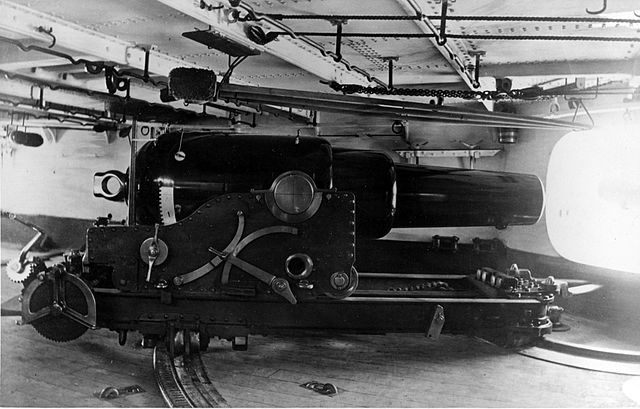
The Asar-i Şevket class had just a single 229 mm (9 in) muzzle loading Armstrong gun (versus eight 220-millimeter (8.7 in) muzzle-loading guns on Tewfik) but four lighter 178 mm (7 in) Armstrong guns instead in the central casemate. The single 229 mm gun was mounted on top in an open barbette mount with much more traverse to fire on all directions. As for performances, the RML 9-inch Armstrong Gun was a popular model, introduced in 1867 and also used by the Netherlands and Spain.
It weighted 12,300 kg and was 3.962 m long for an exact caliber of 229 mm and fired shells at a muzzle velocity of 1,476 feet per second (450 m/s)
7-in/14 Armstrong
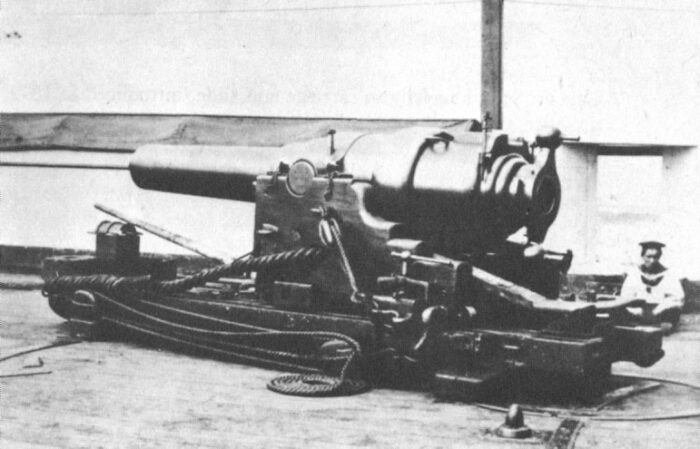
This model was born in 1861. The Barrel length was 99.5 inches (2.527 m) bore (14.21 calibres) and it fired a 90 to 109 pounds (40 to 50 kg) shell with an exact caliber of 177.8 mm. The breech was of the Armstrong screw type with vertical sliding vent-piece block.
Muzzle velocity was 1,100 feet per second (340 m/s) and max range 3,500 yards (3,200 m).
Ugrades and reconstructions
During the 1890 refit, the main battery was kept, but many light guns were added to deal with toepedo boats: Two 87 mm (3.4 in) Krupp guns, two 63.5 mm (2.50 in) Krupp guns, two 37 mm (1.5 in) Hotchkiss revolver cannon, one 25.4 mm (1 in) Nordenfelt gun in all possible places. The appearance of both vessels also changed greatly.

On pinterest, The Ironclad Corvette “Zırhlı Korvet” Asar-ı Şevket, ca.1880
⚙ specifications |
|
| Displacement | 2,047 metric tons (2,015 long tons; 2,256 short tons) |
| Dimensions | 66.4 x 12.9 x 5 m (217 ft 10 in x 42 ft 4 in x 16 ft 5 in) |
| Propulsion | 1 shaft compound steam engine, 4× box boilers 1,750 ihp (1,300 kW) |
| Speed | 12 knots (22 km/h; 14 mph) |
| Range | 300t coal, c2500 nm/8 kts |
| Armament | 1× 229 mm (9 in) Armstrong gun, 4 × 178 mm (7 in) Armstrong guns |
| Protection | Belt: 152 mm (6 in), Battery, Barbette: 114 mm (4.5 in) |
| Crew | 170 |
Career of the Asar-i Sevket class
 Asar-i Şevket
Asar-i Şevket
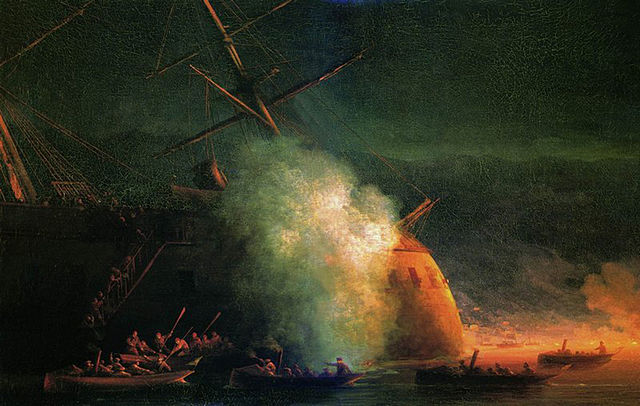
Russian painting of the attack on Asar-i Şevket, depicting her supposed sinking
Asar-i Şevket (“Work of God”) was originally ordered at FCG in Bordeaux as “Kahira”, laid down in 1867, launched in 1868 and completed in 1869. On 5 June 1867 she was surrendered while in completion to the Ottoman Empire and integrated officially on 29 August 1868, renamed, and properly recommissioned on 3 March 1870.
Her first intervention was to try to end the Cretan Revolt of 1866–1869. Under Hobart Pasha she remained largely inactive and training was confined to reading translated British instruction manuals like her sister. She was in the I Squadron, Asiatic Fleet, with her sister and Hifz-ur Rahman, Lütf-ü Celil. Early in her career she was placed in reserve and only activated for summer traning cruises from the Golden Horn to the Bosporus, just to check her propulsion system. There was no drills nor fleet manoeuvers.
The Russo-Turkish War from September 1876 was her first serious commitment, after the insurrection in Ottoman Bosnia, Serbia declared war on the Ottoman Empire in July. War was declared on 24 April 1877 and Asar-i Şevket, transferred to the I Division, Mediterranean Fleet, was retransferred to the Black Sea squadron, joining the fleet under Hobart Pasha. The Russians could do little with only the Vitse-admiral Popov and Novgorod and they kept two corps in reserve for coastal defense. The Ottoman fleet sailed to the eastern Black Sea to support the Ottoman campaign in the Caucasus, bombarding Poti and defending Batumi.
In May 1877, Asar-i Şevket with the frigate Mubir-i Sürur, and transports entered Batumi and were soon attacked the first night by Russian spar torpedo boats. Asar-i Şevket was not damaged. By late June, Asar-i Şevket was transferred to Sulina, mouth of the Danube as well a sMuin-i Zafer and Hifz-ur Rahman to defend the seaward approach to the port alongside three coastal fortifications. In August she was sent to guard Sukhumi. On the night of 24 August, four Russian torpedo boats attacked and one anaged to detonate her spar torpedo, claiming to sink her. There was superficial hull damage indeed, with some plates buckled, but she was in now way in perile.
In 1878, Asar-i Şevket was laid up in Constantinople and did little between low budgets and inetrnal political instability. Summer cruises ended and in the 1880s she was maintained in permament reserve, without maintenance nor crews. Asar-i Şevket was tested in 1885 and proved was unable to steam away with a hull badly fouled. The British naval attache reported it would need six months to have five ironclads serviceable again. She was still assigned a seleketon but when tension with Greece flared up in 1886, the fleet was fully crewed and they were asked to try to service and maintain the ships, preparing them to sail out, but this never happened.
All remained stuck in Golden Horn, quickly laid up again. Both Sevket class ironclads barely managed between 4 to 6 knots (7.4 to 11.1 km/h; 4.6 to 6.9 mph) when tested and in 1890, the sisters were taken to the Imperial Arsenal for refitting, they were gutted, the boilers were retired and new boilers installed, while thrir old engine was dismounted and all parts cleaned up and checked. She also received a battery of light guns and was recommissioned on 12 February 1892.
Her next commitment, in better shape, was the Greco-Turkish War started in February 1897. Still, between 1892 and 1897, no maintenance had been done at all, and the ships, including Asar-i Şevket, were inspected and judged “unfit for combat”. The wooden vessels had rotten hulls, those with iron hulls were encrusted and rust was everytwhere. Plus their crews had been disbanded years prior and those new ones were poorly trained and unable to manage the artillery. In April and May, anyway, the Pasha brought the fleet for a symbolic sortie into the Aegean Sea, trying to raise morale.
Asar-i Şevket and others went up to Naga, Dardanelles and sailed back. Foreign observers and journalists reported this and it became an embarrassment for the government. Abdul Hamid II was eventually ready to ask for a modernization program to be made this time in foreign shipyards. Krupp, Schichau-Werke, and AG Vulcan were preferred, but invited, they withdrew after surveying the general state of the ships in December 1897. There were doubts also with the Ottoman government will to pay for the work at all. Asar-i Şevket was excluded from the program when awarded for budgetary reasons and decommissioned in 1903, sold for BU on 31 July 1909.
 Necm-i Şevket (1870)
Necm-i Şevket (1870)
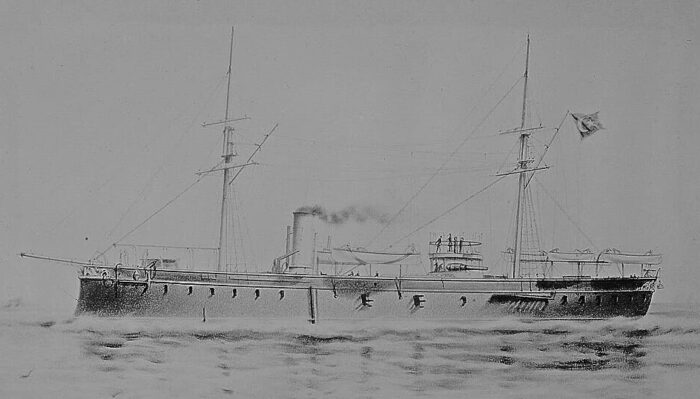
Necm-i Şevket (“Star of Majesty”) was built at French Forges et Chantiers de la Gironde shipyard, Bordeaux as Muzaffer, laid down in 1867, launched in 1868 and like her sister, surrendered to the Ottoman government, renamed, recommissioned on 3 March 1870. Her career mirrored her sister: Intervetion in Crete and summer cruises to the Bosporus under Hobart Pasha as part of the I Squadron of the Asiatic Fleet with her sister, Hifz-ur Rahman and Lütf-ü Celil.
In September 1876 she was prepared for war she took part in the Russo-Turkish War from 24 April 1877 with the Black Sea squadron, and sailed wit the fleet for the Caucasus campaign, eastern Black Sea, attack of Poti and defense of Batumi.
On 14 May 1877 with Avnillah, Muin-i Zafer, Feth-i Bülend, Mukaddeme-i Hayir, and Iclaliye she bombarded the defenses of Sokhumi and eased its capture but the fleet was attacked several times by Russian torpedo boats. She remained unharmed.
On 7 March 1878 Necm-i Şevket collided with the British steamship John Middleton at Tophane, driven into HMS Antelope, and sank. HMS Antelope was severely damaged and rescued her crew. It was attributed to poor handling at the time. In 1878, Necm-i Şevket was laid up in Constantinople. Lacking maintenance in 1885 it was assessed her hull was badly fouled and boilers in poor state, she was unable to steam. In 1886 despote high tensions with Greece she remaine dinactive in the Golden Horn before being laid up again. Still she was sent to the Imperial Arsenal for refitting, new boilers installed and light guns, recommissioned on 12 February 1892.
But this had little effect as she returned in reservr and when the Greco-Turkish War flared up in February 1897, Necm-i Şevket was assigned to the II Squadron but after inspection was found unfit for combat but still in “usable condition” like Mesudiye. In April-May she escorted troopships from western Anatolia to Gelibolu and even had gunnery exercises. On 15 May with Mesudiye, Osmaniye, Aziziye, and Hamidiye she took part in a major training exercise, revealing the crew was unable to operate the artillery properly. The war ended and she saw no action.
When Abdul Hamid II authorized a modernization program she was surveyed and in 1900, contracts were awarded but excluded Necm-i Şevket like her sister. She became a stationary in Selanik (1899 to 1909), then converted into a barracks ship in Constantinople. She was fully reactivated and crewed on 30 October 1912 to take part in the First Balkan War, towed to Çatalca with the ironclad Iclaliye, remaining as floating battery for a few days, later joined by Barbaros Hayreddin and Turgut Reis, Mesudiye and Asar-i Tevfik. She was towed to Büyükçekmece until 20 November, and returned as barracks ship postwar, then decommissioned in 1929, BU.
Read More/Src
Books
Barry, Quintin (2012). War in the East: A Military History of the Russo-Turkish War 1877–78. Solihull: Helion. ISBN 978-1-907677-11-3.
Greene, Jack & Massignani, Alessandro (1998). Ironclads at War: The Origin and Development of the Armored Warship, 1854–1891. Pennsylvania: Combined Publishing. ISBN 978-0-938289-58-6.
Langensiepen, Bernd & Güleryüz, Ahmet (1995). The Ottoman Steam Navy 1828–1923. London: Conway Maritime Press. ISBN 978-0-85177-610-1.
Lyon, Hugh (1979). “Turkey”. In Gardiner, Robert (ed.). Conway’s All the World’s Fighting Ships 1860–1905. London: Conway Maritime Press. pp. 388–394. ISBN 978-0-85177-133-5.
Sturton, Ian. “Through British Eyes: Constantinople Dockyard, the Ottoman Navy, and the Last Ironclad, 1876–1909”. Warship International. 57 (2). Toledo: International Naval Research Organization. ISSN 0043-0374.
Links
On navypedia.org/
on tr.wikipedia.org/
on en.wikipedia.org/
doctorate thesis on etheses.bham.ac.uk THE MODERNIZATION OF THE OTTOMAN NAVY DURING THE REIGN OF SULTAN ABDÜLAZİZ (1861-1876) by DİLARA DAL
Iron Ships and Iron Men: Naval Modernizaton in the Ottoman Empire, Russia, China and Japan from a Comparative Perspective 1830-1897 Emir YenerEmir Yener
on youtube
scalemates.com/ fairy-kikaku asar-i-tevfik 1912
on klueser.de/

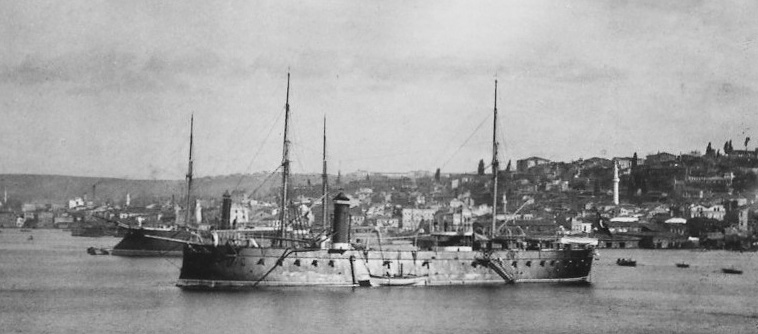
 Latest Facebook Entry -
Latest Facebook Entry -  X(Tweeter) Naval Encyclopedia's deck archive
X(Tweeter) Naval Encyclopedia's deck archive Instagram (@navalencyc)
Instagram (@navalencyc)





 French Navy
French Navy Royal Navy
Royal Navy Russian Navy
Russian Navy Armada Espanola
Armada Espanola Austrian Navy
Austrian Navy K.u.K. Kriegsmarine
K.u.K. Kriegsmarine Dansk Marine
Dansk Marine Nautiko Hellenon
Nautiko Hellenon Koninklije Marine 1870
Koninklije Marine 1870 Marinha do Brasil
Marinha do Brasil Osmanlı Donanması
Osmanlı Donanması Marina Do Peru
Marina Do Peru Marinha do Portugal
Marinha do Portugal Regia Marina 1870
Regia Marina 1870 Nihhon Kaigun 1870
Nihhon Kaigun 1870 Preußische Marine 1870
Preußische Marine 1870 Russkiy Flot 1870
Russkiy Flot 1870 Svenska marinen
Svenska marinen Søværnet
Søværnet Union Navy
Union Navy Confederate Navy
Confederate Navy Armada de Argentina
Armada de Argentina Imperial Chinese Navy
Imperial Chinese Navy Marinha do Portugal
Marinha do Portugal Mexico
Mexico Kaiserliche Marine
Kaiserliche Marine 1898 US Navy
1898 US Navy Sovietskiy Flot
Sovietskiy Flot Royal Canadian Navy
Royal Canadian Navy Royal Australian Navy
Royal Australian Navy RNZN Fleet
RNZN Fleet Chinese Navy 1937
Chinese Navy 1937 Kriegsmarine
Kriegsmarine Chilean Navy
Chilean Navy Danish Navy
Danish Navy Finnish Navy
Finnish Navy Hellenic Navy
Hellenic Navy Polish Navy
Polish Navy Romanian Navy
Romanian Navy Turkish Navy
Turkish Navy Royal Yugoslav Navy
Royal Yugoslav Navy Royal Thai Navy
Royal Thai Navy Minor Navies
Minor Navies Albania
Albania Austria
Austria Belgium
Belgium Columbia
Columbia Costa Rica
Costa Rica Cuba
Cuba Czechoslovakia
Czechoslovakia Dominican Republic
Dominican Republic Haiti
Haiti Hungary
Hungary Honduras
Honduras Estonia
Estonia Iceland
Iceland Eire
Eire Equador
Equador Iran
Iran Iraq
Iraq Latvia
Latvia Liberia
Liberia Lithuania
Lithuania Mandchukuo
Mandchukuo Morocco
Morocco Nicaragua
Nicaragua Persia
Persia San Salvador
San Salvador Sarawak
Sarawak Uruguay
Uruguay Venezuela
Venezuela Zanzibar
Zanzibar Warsaw Pact Navies
Warsaw Pact Navies Bulgaria
Bulgaria Hungary
Hungary

 Bundesmarine
Bundesmarine Dutch Navy
Dutch Navy Hellenic Navy
Hellenic Navy Marina Militare
Marina Militare Yugoslav Navy
Yugoslav Navy Chinese Navy
Chinese Navy Indian Navy
Indian Navy Indonesian Navy
Indonesian Navy JMSDF
JMSDF North Korean Navy
North Korean Navy Pakistani Navy
Pakistani Navy Philippines Navy
Philippines Navy ROKN
ROKN Rep. of Singapore Navy
Rep. of Singapore Navy Taiwanese Navy
Taiwanese Navy IDF Navy
IDF Navy Saudi Navy
Saudi Navy Royal New Zealand Navy
Royal New Zealand Navy Egyptian Navy
Egyptian Navy South African Navy
South African Navy






























 Ukrainian Navy
Ukrainian Navy dbodesign
dbodesign